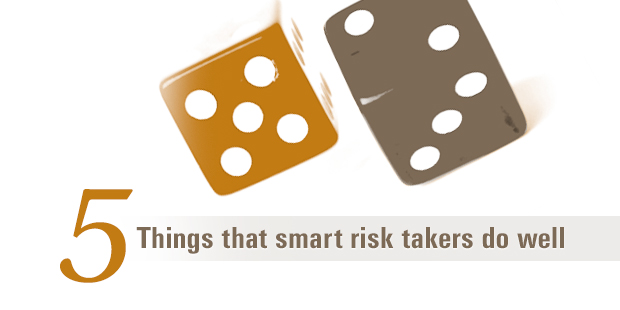
5 Things Smart Risk Takers Do Well
Doug Sundheim’s book, Taking Smart Risks, isn’t really about making your next risky decision smarter or safer; it’s about pushing all of your choices to be riskier, but smarter on a daily basis.
We tend to view our choices as risky or safe. Safe is good while risky is well, risky. You’re taking a chance with a risky choice; it could lead to ruin. Sundheim says that view doesn’t capture the essence of what taking a risk is all about. Taking a risk is “exposing oneself to the possibility of loss or injury in the hopes of achieving a gain or reward.” It’s really the reason we would consider taking a risk rather than just playing it safe. It’s not an either/or proposition—safe or risky. But because we perceive it that way, we tend to do all we can to avoid risk and stay in our comfort zone.
Sundheim lists five common dangers of playing it safe for too long:
• You don’t win.
• You don’t grow.
• You don’t create.
• You lose confidence.
• You don’t feel alive.
Are you caught in the comfort zone? Here’s a thought we can all relate to:
Being caught in the comfort zone doesn’t mean that you’re sitting around doing nothing. It’s more nuanced than that. You could be making progress, but not quickly enough. You could be taking chances, but not boldly enough. You could be going out on a limb, but not far enough, and the extra push is what will make a difference.
What Sundheim is advocating is a change in our mindset regarding risk. Rather than perceiving risk as negative (“Things may not be perfect now, but they’re not all that bad. If I make a move, things could end up worse. I’d better not risk it.”), we should view it as a balanced focus on both the downside of taking risks and not taking risks (“I’ll regret it if I don’t pursue this thing. I’ve got to find some smart ways to take risks to move it forward.”). A limiting mindset versus a liberating mindset.
The shift from limiting to liberating is “a move from needing total security before moving forward to understanding that you can’t have total security before moving forward.” Between safe and risky is the smart-risk zone.
Smart risk takers consistently do five things well to disrisk whatever they’re up to:
- Find something worth fighting for. It is what all smart risks have in common. It must be simple, stir emotion, lend itself to a story or narrative, and inspire action.
- See the future now. Ask questions, understand concerns, test the concept behind your ideas, and predict as many fail points in advance that you can. Have an open, honest conversation with trusted people around you to determine what is the worst that could really happen.
- Act fast, learn fast. Start before you know where to start, fail early, often, and smart—build learning into everything, and stay humble. Accept that you have to live with failure—since it is an inevitable by-product of taking risks, even smart risks. Failing smart is the best way to learn.
- Communicate powerfully. Expect communication to break down and plan accordingly. Share thought processes, meet regularly, and don’t avoid difficult conversations.
- Create a smart-risk culture. Define a smart failure—the acceptable boundaries within which it is okay to fail. Reward both the successes and these smart failures.
Communication is a critical element of each of these stages. “At every stage of any risk, improving the way in which you discuss thoughts, plans, and actions is the single most effective way to derisk the risk, that is, to make it smart.”

Tags: Innovation, Leadership Development, Michael McKinney, risk











